How To Clean Return Ducts With Negative Pressure
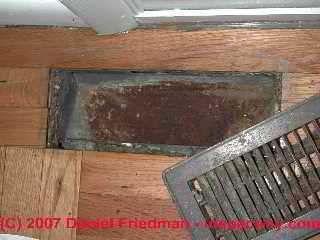 Wet or Corroded Heating or Cooling Ducts
Wet or Corroded Heating or Cooling Ducts
Causes, Health Concerns, Repairs for wet air ducts
- POST a QUESTION or Comment about the cause, detection, effects-of and cures for wet, flooded, water ice or water contaminated ductwork
InspectAPedia tolerates no conflicts of interest. We accept no human relationship with advertisers, products, or services discussed at this website.
Air duct leaks, condensation, flooding or wetting = contagion:
This article describes Wet or Corroded Heating & Cooling Ducts: Cause, Health Concerns,& Repairs to right this condition. Rusty metal ducts or corroded HVAC ducts are an indicator of improper and possibly unhealthy conditions in the building as they are most always associated with unwanted moisture in the duct system.
Unwanted wet in cooling ducts in item, is an invitation to mold, bacterial, or other pathogens in the duct system and thus in the building air. Nosotros point out and include photographs of locations where you lot tin can spot unwanted HVAC or cooling system moisture and rust, cite some related health concerns, and talk over ways to avoid duct corrosion or rust. We also offer advice on what to practise nigh rusty ductwork.
We besides provide an Commodity Index for this topic, or you can endeavour the page tiptop or lesser SEARCH BOX as a quick way to find data you need.
Flooded, Wet, or Iced Air Ducts, Causes & Cures for Wet or Corroded Air Conditioning Duct Work
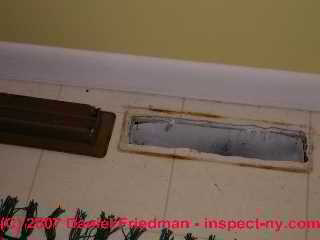
The photo at page pinnacle shows a very rusty air-conditioning ductwork annals, and a careful look into that organization of metal duct work, constitute additional heavy rust in the duct system along with lots of debris.
The photographs shown just higher up are of a less obviously rusty duct organization and the rust stains on the vinyl floor suggest that the h2o in this duct organization came from the floor level.
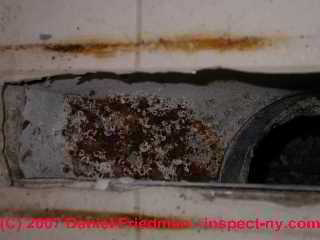
[Click to enlarge any image]
Article Contents
- WET CORRODED DUCT WORK
- DUCTWORK Moisture SOURCES
- DUCTWORK MOISTURE HAZARDS
- DUCTWORK MOISTURE RISK ASSESSMENT
- Wet DUCTWORK REPAIRS
Causes of & Cures For Water or Moisture In HVAC Ducts & Air Handlers

Excessive indoor humidity and its related mold, grit mite, or bacterial hazards may be traced to either a crusade or an event of loftier moisture inside of an air conditioning system or even heating system duct work or air handler. Here are some common examples of sources of condensation or actual water leaks in HVAC duct systems:
- Missing HVAC duct insulation: voids in the insulation or un-insulated supply ducts on an air conditioning ductwork system are probable to cause considerable condensation on the duct exterior wherever the ducts pass through un-conditioned space such as an cranium flooring where the ducts are exposed to warm moist air.
Some brands of HVAC flex duct accept been particularly decumbent to loss of both the outside plastic duct covering and ultimately the duct insulation itself.
Come across GOODMAN GRAY FLEXDUCT for examples of this problem (photo at left).
External condensation on supply ducts is sufficient to evidence up every bit a ceiling leak or stain.
Internal condensation may also occur in the duct organisation where insulation is missing. The aggregating of condensate on the duct interior too risks growth of bacterial, mold or other contaminant hazards.
- Convection air currents: when an HVAC system is off, depending on edifice temperatures, air may circulate upwardly through ceiling ducts or other ducts by natural convection, carrying moisture that condenses in cooler duct sections (such as in a common cold attic in winter) where the condensate in the ductwork may really form frost or ice that afterwards melts and shows up as a ceiling leak stain.
See WATER & Ice IN DUCT Work
- An over-sized central air conditioner, even an over-sized room air conditioner may absurd the building area so quickly that the A/C system does non run long enough to adequately dehumidify the edifice air. A event can include accumulation of condensate in the ductwork interior, specially if the ductwork insulation is incomplete. Details are
at DEHUMIDIFICATION PROBLEMS.
- High indoor moisture moving through the building (a wet basement or crawl space) often transport moisture up through the entire building, overwhelming central air-conditioning or local dehumidifier's ability to dehumidify the building air to an acceptable level. Ceiling-mounted air ducts may circulate moist indoor air into the duct arrangement by convection even if the blower or air handler is not running. In winter moisture may condense, fifty-fifty freeze and accrue in such duct systems.
See WATER & ICE IN DUCT Work
and alsoencounter HUMIDITY CONTROL & TARGETS INDOORS
- Leaky HVAC ducts or duct connections: leaks in return ducts, because they are under negative force per unit area, can bring warm moist unconditioned air into the duct organisation adding to both contamination and wet condensation problems there.
Run into LEAKY DUCT CONNECTIONS
andrun across Render DUCT AIR LEAKS or
see SUPPLY DUCT AIR LEAKS
- Leaks or bodily overflowing-waters entering the HVAC duct work from a roof leak, plumbing leak, or from a humidifier that is improperly adjusted or improperly located can induce excessive moisture into building air likewise as inviting mold contamination of the HVAC system. An extreme case of this trouble occurs when a building has been really flooded.
See Overflowing DAMAGED DUCT WORK
andrun into FLOOD Damage HEATING EQUIP.
- In-slab HVAC ducts are often subjected to leaks into the duct system or moisture and water drove from footing-water, from plumbing leaks, or from condensation;
see TRANSITE PIPE AIR DUCT ASBESTOS RISKS an instance
orrun into SLAB DUCTWORK
- Condensate blow-off from the cooling gyre in an air handler will often wet the supply plenum and nearby ductwork in some very humid climates.
Unless there is likewise a condensate drainage trouble in the air conditioner we don't usually see extensive trouble mold growth from this blow-off event, just equally the following reader comment (originally posted
at HUMIDITY Command & TARGETS INDOORS) explains, in loftier-velocity air-conditioning systems condensate blow-off can be and so extreme every bit to create a serious indoor moisture problem.
Examples of condensate spill-over inside of an air handler blower compartment, a condition creating a take chances of mold growth inside the HVAC system are
at BLOWER LEAKS, RUST & MOLD
See MOLDY Growth in Air Conditioning Blower Fans for an example of mold growth on the air handler blower that was probably encouraged by condensate.
- Sagging poorly-supported ductwork encourages the collection of condensate in depression portions of the ductwork. Nosotros show two sagging flex-duct examples just beneath.
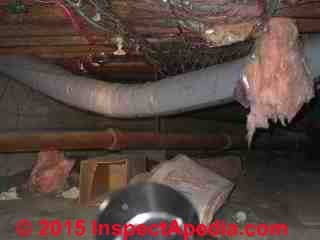
See DUCT ROUTING & SUPPORT
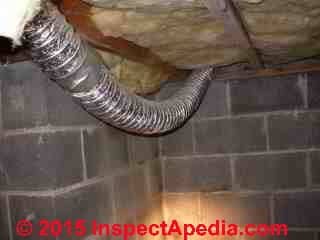
Excessive indoor humidity traced to wet air ducts caused by loftier velocity air conditioning system coil condensation blow-off
Reader Comment: Mike / DFW
For years I've been trying to effigy out the excessive humidity problem in my home too. I finally found it later working with foundation people, plumbers, a/c techs -- nobody could figure it out, simply I finally did. When the cooling kicks on, the moisture level skyrockets. It has afflicted the inside of my home tremendously. We thought it was the a/c drain.
They re-routed it, fabricated sure information technology was draining well and articulate. It is. Leak near or under the foundation. We checked everything-that wasn't it.
What's happening is the fan is actually sucking the wet out of the evaporator coils before the condensation off the coils can drain away. The design of this Lennox horizontal system in the attic is such that the pocket-sized space correct above and right below the squirrel type fan, creates a venturi effect, increasing the velocity of the air existence sucked into the fan.
The velocity of the air is so strong that the coils (about 12 in. abroad) have the wet sucked correct off of them and into the fan, which, of course is so blown into the ducting. I'one thousand not sure if this is an engineering design trouble, if the a/c co. wired the fan to a speed that's too high, or if perhaps a part is missing that is supposed to foreclose this.
Regardless, the inside of the unit is at present so covered with mildew and mold and the electrical connections on the heating elements as well equally all the electrical connections on the within of the unit of measurement, are and so corroded and rusted, it'south a wonder that honey thing works at all. (This besides probably explains why sometimes the oestrus works and sometimes it doesn't.
The a/c repair guys have never been able to figure out why. They always seem to remember it's the thermostat It'south not. It'due south new and has recently been completely re-wired when I moved it from an exterior wall to an inside wall.)
Anyway, that'south where MY moisture problem is coming from. Good luck! - Mike / DFW 12/13/2012
Reply:
Mike, aureate star to you for good detective work. Like other areas in the Southern U.Due south., Dallas/Fort Worth experiences seasonal periods of high humidity that can effect in an extraction rate of water from building air faster than the design of the air handler and condensate drain system can handle it.
More than about dehumidification issues traced to cardinal air conditioning systems can be read
at DEHUMIDIFICATION Bug.
Do you remember that the root problem, so, is an improper duct or plenum size or design or a mismatch betwixt blower fan capacity and the HVAC duct system?
Are Rusty, Previously-Wet, Iced, or Muddied Ac Ducts a Health Business organisation?
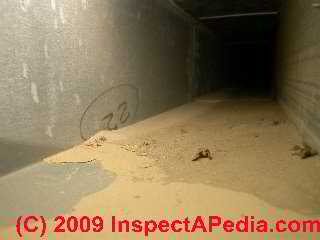
Non necessarily: To avoid inappropriate anxiety on the role of whatsoever readers we state upwards forepart that it is normal for some dust and debris to accumulate on the inside of heating or air conditioning ducts, and this cloth is not necessarily a gamble to edifice occupants.
Just when ducts have also been wet, or when ducts are constructed of materials like fiberglass insulation that have been damaged or tin't be cleaned, some potential wellness or respiratory issues may be nowadays, as we discuss further here.
Our flooded air duct photo (above left) shows ductwork with a layer of mud - this habitation was flooded to a level that included ceiling-mounted basement air ducts. The ducts needed to be cleaned and sanitized.
Soil particles themselves may not exist a serious health adventure but area flooding often brings pathogens (such as leaner or viruses found in sewage) into buildings and can form a serious health hazard. Details are
at FLOOD Impairment in DUCT Piece of work.
Rust flakes from rusty heating or air conditioning ducts themselves are unlikely to be much of a health hazard - these particles are pretty large, not easily airborne, and probably won't be found at high levels in indoor air except in unusual circumstances. Simply rust in ducts is a problem indicator, showing quite conspicuously that the duct system has been wet.
Grit & normal air duct debris: The principal components of house dust, which will certainly collect inside a duct system include cloth fibers and skin cells, ofttimes besides including starch fragments and other organic droppings.
Sentry out: The combination of organic debris inside a duct system and water (indicated by rusty ducts or duct registers) indicates a possible risk of mold or bacterial hazards within the air workout or heating system. Since blowing air through the system can option up and distribute these hazards to occupants of the building, wet or previously-wet duct work is a potential wellness risk to edifice occupants.
Wet HVAC Ductwork Bodily Risk Cess
The actual health hazard level from wet or previously moisture air-conditioning or heating ducts in a edifice depends on these factors:
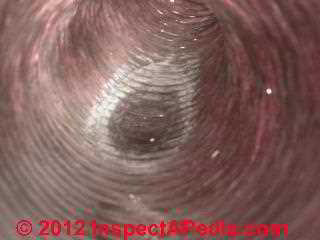
- The total area of duct or other surfaces that have been wet, including both duct system interior and the interior of the air handler or fan/blower unit of measurement and evaporator roll surface
- The level of organic debris inside the duct organisation. Our photograph (left) illustrates a small wet area in a section of flexible air duct - a trouble that should exist corrected. Only if this is the simply moisture area it does non itself appear to be a wellness hazard. Make sure that flexible ductwork is properly supported to avoid collecting condensate in depression spots.
- Presence of visible mold contamination in the duct system or within the air handler itself. Minor amounts of mold, frequently a species or two of Cladosporium course on blowers and in small areas of the air handler.
While even some species of Cladosporium, the almost common mold family, can be a health hazard, a greater risk is likely to be present if the arrangement is contaminated with small, hands-airborne molds such as those in the Aspergillus and Penicillium families.
These are less unremarkably found as are ductwork mold contaminants that originate non from growing mold colonies in the duct system or air handler but from other building mold reservoirs.
Encounter MOLD in AIR HANDLERS & DUCT Work
Since odors, including moldy smells, are easily transported from one building to another through its HVAC system, sorting out moldy smells or other odors and tracking them to their source tin be tricky.
Run into ODORS in AIR HANDLERS & DUCT Piece of work
- The materials used to insulate the duct interior: fiberglass and similar materials form a "mucilaginous" surface that tends to agree debris and also to act as a sponge holding moisture, possibly increasing the risk of mold or bacterial hazards, and not easily cleaned.
- The frequency of wet weather condition: recurrent wetting manifestly increases the take a chance of pathogens in the duct work, though nosotros've seen significant contagion as a result of a single building flooding issue which wet the ducts
- The wellness vulnerability of individual occupants in the building: elderly, immune-impaired, asthmatics, infants, people with allergies, people with COPD or other respiratory illness, are more than likely to be bothered sooner by duct contaminants that are produced by moisture conditions in the ac or heating organisation.
What To Do Most Rusty HVAC Ducts, Wet or Previously Wet Fiberglass Ducts or Flex-Duct
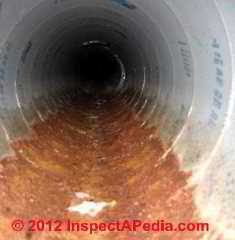
- Clean the ductwork: Metal ducts that accept been wet but are non severely damaged can and should be professionally cleaned. Exist sure that the interior of the air handler is also inspected and cleaned.
- Replace damaged ductwork: Where you notice metal duct system components which are quite corroded, badly corroded materials should exist replaced. Depending on the location of the ductwork and its accessibility, this might not involve meaning expense if only express sections of readily-accessible duct work are involved.
- Replace fiberglass-lined ducts that take been moisture: Fiberglass-lined ducts or flex-ducts which have been wet should be inspected thoroughly, and sections which were wet and/or are particularly soiled should be replaced. While information technology may be possible to remove-and re-line HVAC ducts that use an interior fiberglass lath liner, if more than than a minor corporeality of such work is needed, replacement of the ducts may be less costly.
- Audit for significant mold reservoirs in the ductwork: Leaks into ducts routed through inaccessible building areas or cavities, and leaks into duct work which has insulation, specially fiberglass insulation, in its interior, (typically fiberglass board), may harbor a mold colony, leading to both pregnant cleanup costs and potential health concerns.
Employ of Sprays, Sealants, Sanitizers in HVAC Duct Systems
Reader Question: because buying a business firm with very corroded in-flooring rusty ductwork - can we just spray-seal the duct interiors?
I am because ownership a 20 year old firm which has underground ducting serving both refrigerated air and heat.
I had a duct inspection which revealed severely corroded and rusted ducts with some holes through the ducting.
I have heard of a production past the Duct Seal Technologies in which the inside of the ducts are sprayed with a coating of kevlar fibers and some bonding agent. Do you know anything about this procedure?
Thanks, Doug Spence - Spence 6/xix/2011
Respond: in-slab HVAC ducts are request for trouble from flooding, vermin, h2o, mold, etc.
Spence:
About buried or in-floor HVAC ducts: as we suggest in the article above, even if you could reliably reline your in-ground or under-slab air ducts (and how without a detailed inspection would nosotros know that the re-coating or relining was complete, and that information technology remained intact?) there remains a business organisation with radon gas or water leaks into the duct system.
And we are hundred-to-one about the reliability of this arroyo: spray-on coatings don't bond well to dirty, rusted, corroded surfaces and may neglect to seal large penetrations or holes; And even a well-sealed spray-coated in-slab HVAC duct, if subjected to future flooding from ground water or plumbing leaks, or invasion by rodents or other pests, is simply going to take new contagion in its interior.
Run across DUCTWORK CONTAMINATION
A better, but usually much more costly and confusing solution is to eliminate the in-slab ductwork by rerouting it through the building.
If you become ahead with the process I'd recommend start an inspection for evidence of a history of duct flooding, and an annual inspection of the duct condition until you are confident of its dryness and cleanliness.
Also take a look at TRANSITE Piping AIR DUCT ASBESTOS RISKS for more than examples of problems with heating or air-conditioning ducts constitute in slabs.
Reader Comments & Q&A
Question: what is causing fan motor and shaft rust in my Unico Mini Duct System
JL 2022/07/01
I have Unico mini-duct organisation in my attic. Every wintertime, the fan motor and shaft accumulate rust. I live in a very cold climate in winter (Vermont). Last year, I had the motor replaced and this spring, at that place was rust on the motor again (no visible rust last Fall when I closed the unit up for the winter). I had the New England Unico rep at my house when nosotros airtight upwardly the unit for wintertime to ensure it was properly winterized.
Specifically, the plugs were put into all the outlets and a piece of insulation board wrapped inside a plastic garbage bag was placed tightly into the air return. In addition, I had an boosted xviii inches of cellulose blown into the attic last autumn and the cranium entrance / jacob's ladder was sealed upwards properly and a new roof put on (both final Fall).
The condensate drain used to bleed into the sewer vent but that was moved last summertime to instead bleed to the outside of the business firm straight via a PVC drain pipe. Note there is just a small five-shaped trap on that PVC drain merely my contractor thinks that is fine given information technology drains to the exterior.
So, the current theory is the rust is occurring due to moisture in the attic in the winter, but there are no other signs of moisture in the attic. The laundry room is almost straight below the attic A/C unit and the dryer vents to that outside wall.
A friend suggested that dryer vent could exist blowing warm air that rises up into the soffit vents and finds its mode into the attic, but I recollect this is not probable the problem given I accept no other signs of moisture in the attic plus the fact that the A/C unit is pretty tightly sealed up itself to avoid leaking air when it is operating.
This Q&A were posted originally at AIR HANDLER / BLOWER UNITS
Moderator respond: track downwardly source of moisture, rust, corrosion in air handler
From your description of near-heroic measures to try to close off your attic duct arrangement in winter one might guess that you've had reason to be concerned for moisture or ice accumulation in ductwork in the past.
What you've been doing sounds reasonable to me.
Just I've also seen that the natural wish of warm air to ascent into absurd spaces means that even the smallest air leak into the duct arrangement from anywhere volition invite moist air and condensation and thus moisture collection during cold conditions.
Because the ductwork is out of use there'due south no air apportionment through the A/C system so no moisture removal; so any moisture accumluates, and tin be corrosive.
I've even seen so much wet accumulate in cranium ducts equally to course thick ice that afterwards melts and shows up equally a "leak" that has been mistaken for roof leaks.
If air is leaking directly into the duct system from anywhere in the warmed building during winter, that could explain why you see duct or attic AHU moisture signs just not other wet or condensation signs in the remainder of the attic.
Your friend's idea nearly the dryer vent is interesting and helpful as a model: look for sources of warm air leakage into the duct system from anywhere in the edifice.
Two manufactures you'll desire to review are
Water & Water ice IN DUCT Piece of work
Wet CORRODED DUCT Piece of work -- I will copy our discussion to that commodity and will welcome your further comments, questions, suggestions here or there.
Reader follow-upwards:
Thanks for the reply.
I take had some condensation in by years effectually the air outlets (I.e. on the ceiling around the outlets) during very cold spells. That is one reason I had more insulation put in the attic last Fall when the roof was being replaced. Now most of the ducts in the attic are buried in insulation. No problems similar that this past winter after adding the insulation.
The links you sent me don't piece of work for me. Can yous please double-check them?
The almost likely place I tin can think of where air from the heated function of the house would be the return. Tin you call up of whatsoever special material the render should exist made of or method of sealing (beyond what I'm doing)?
Regarding the condensate drain, practise you recollect I demand a bigger bleed with antifreeze in it during the winter to keep air from getting into the unit in winter? Keep in mind it is currently just a pocket-size V-shaped PVC trap that drains outside.
One last question: is information technology possible the corrosion actually occurs during the summer/fall when the unit is operating simply doesn't turn into visible rust over time (e.thousand. wintertime)?
Thanks again! - JL
Moderator respond: example of how to utilize InspectApedia.com on-folio search box results
[Click to overstate whatsoever image]
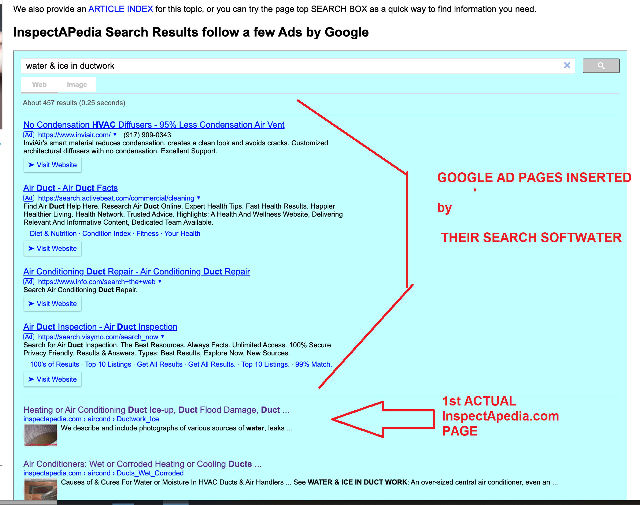
RE your question:
Can yous remember of whatever special material the return should exist made of or method of sealing (across what I'm doing)?
-- If you lot are sealing the return duct at its inlet grille then that is normally sufficient; only you might want to inspect the duct system to be certain there are no obvious air leaks into it from elsewhere.
-- Something sounds wrong about all of this: when nosotros close off duct inlets and outlets we should be closing off any meaning air drafts into the ductwork during the off-season; So I keep thinking nosotros're missing a significant airflow passage.
Regarding the condensate drain, do yous think I need a bigger drain with antifreeze in it during the winter to proceed air from getting into the unit in winter? Keep in mind it is currently just a pocket-size V-shaped PVC trap that drains outside.
-- The condensate drain trap may indeed dry out over winter; you could endeavor mineral oil in the trap when the system is close off - less of a contaminant than antifreeze;
Ane terminal question: is it possible the corrosion actually occurs during the summer/fall when the unit is operating but doesn't plough into visible rust over fourth dimension (e.g. winter)?
-- It is certainly possible that moisture is accumulating in the duct organization during the in-use season and lying there corroding-away over the winter; It's mutual for water to blow off of the cooling curl into the supply ducts from that betoken onwards.
-- Sags in ductwork likewise pool condensate;
Reader follow-up:
Thanks for all the info. Your last signal fabricated me ponder something anybody has said should not exist an event simply let me run information technology by you: I have 2 outlets over my two-story foyer that crave an extension ladder to plug / unplug so I stopped opening them several years ago.
Do you think it is possible that because the air isn't moving through those lines (remember this is a Unico high velocity mini-duct system) that there could be condensation sitting in those lines that could observe its way back to the blower fan in the winter? FYI: I typically run the blower fan (i.e. not calling for cooling) for at least 24 hours before endmost up the organization for winter.
This is unremarkably in October when the nights are cool and I'm no longer using the organisation daily for cooling. Could that exist leading to warm moist air in the ducts that later causes the rusting on the blower fan once I close the organisation for winter?
My technician is supposed to come to supervene upon the blower fan and motor today so I'll run some of these ideas past him as well. - JL
Moderator reply:
I'll be very interested in your report of what your on-site service tech has to say, as nobody can see as much by text and web posts;
But in general, for an outdoor receptacle to exist responsible for rust and moisture in an HVAC duct system you'd have to have a pretty unusual circumstance in which sufficient volume of humid outdoor air is somehow conducted from an electric box or the cutout opening for the box into the duct system. In that location should exist no direct path through which that'south possible. Visual inspection nevertheless is sensible.
Reader follow-upward:
My technician agreed to problem cannot exist caused by the dryer venting support into the cranium. The Unico organisation is pretty air tight due to it being a high velocity organization.
He also did not think the ii outlets that I never open would be the source of condensation for the winter months. Nor did he recollect running the fan in October simply before I close it upwardly could cause backlog moisture to accumulate since the air is pretty dry in Vermont (low humidity) in October. So we notwithstanding have a mystery. He said the unit was completely dry inside today despite the fact it was hot and very humid here yesterday. - JL
So we nonetheless accept a mystery. Thanks for your suggestions and comments though. If we ever figure this out, I'll permit you know.
Moderator reply:
Cheers for the follow-up, practise go along us posted, as what you find will certainly assistance other people too.
In investigating, start at the signal of nigh-concern such as rust or corrosion, and follow the water or h2o indicators, stains, signs, rust patterns, etc.
Anna
Your original photo (farther below) shows rust in the heating or Air-conditioning duct register boxes that in turn are continued to plastic flex duct.
The 2nd photograph shows little rust; the beginning paradigm yous posted shows more rust and may exist a concern - expect for a spill or a leak source.
Those stains suggest there has been water in the ductwork - risking hidden mold or bacterial health concerns.
I just posted about rust in a vent with plastic lined duct, but wanted to share other images for context

I am purchasing a condo and see that in that location is corrosion in the start floor vents. One is worse than the rest (photos attached- 2 of the bad ane and one of some other). I've been reading this thread and run into the recommendation to investigate any rust or corrosion.
When I look at what these vent attaches to, I see what looks similar something lined with black plastic. I would similar to know one) What kind of duct is this and is there still a business concern for rust in the vents? 2) would y'all yet recommend a telescopic of the vents, and 3) does this vent need to be treated in anyway?
The hardwood floors were recently redone and in that location was concern that product spill in the vents caused the corrosion, but the flooring company says that is impossible. Could this be caused by that?
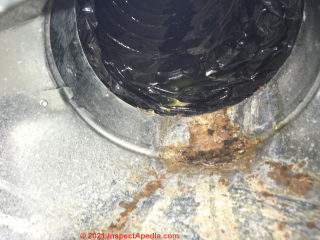
Panther
I tin't say from the photo whether that'south normal dirt in older HVAC returns and ducts or rather h2o damage and mold; if the drywall is damaged wait carefully to see if information technology is from water harm, mechanical damage, or simply the effects of rough cuts fabricated during installation.
Gypsum lath doesn't literally "rot" (equally might wood) but information technology can be h2o damaged and become soft.
In your photo I don't encounter h2o stains. That would be a useful diagnostic clue.
All my air returns look similar this and rotted sheetrock behind them. White motion-picture show and mites all over my home.

Linda
I desire to assist but am totally baffled by the question and by what the service tech told you. I accept not thought why in that location should be a "vent" cut into ductwork - it sounds very odd to me and is by no ways a common, standard, or recommended practice.
Ducts "going in to a furnace", would mean that these are the air return ducts bringing building air into the air handler to be heated (in oestrus mode) or cooled in ac mode.
Sources of water in ductwork are discussed in the article to a higher place; some examples (non an exhaustive list) of causes of water or condensate in or on air conditioning or heating ductwork include:
If there is water inside the duct piece of work it may be due to improper condensate drainage from the air conditioner.
Condensation might too appear on air conditioning SUPPLY ducts (leaving the air handler subsequently the air conditioning cooling coil has cooled air therein) if the ducts are non properly insulated.
On occasion condensate may blow off of the cooling roll and into the supply air plenum or ductwork.
Rarely there are also external sources of h2o inside ductwork such every bit a plumbing leak that drips onto and into ductwork or
finally, ducts that run in flooring slabs beneath class, into which ground water leaks.
The ducts going in to the furnace was dripping and sweating an air conditioner tech said it was because there should be a vent in the duct work that is coming out of the furnace that is running across the ceiling in the aforementioned room.
So he put a hole in the duct, which did stop it from dripping. Should in that location exist a concur in it? Is this correct? My furnace is very erstwhile.
Reader Question: Mold on ceiling traced to condensation in the ductwork?
I accept a condo that the garage is below the living infinite. My tenant noticed in that location is mold on the garage ceiling. One of the neighbors said they had the same problem and she had it fixed. She was told it was condensation in the ductwork. Water was dissentious the drywall and leaking downward.
Of class, mine is worse. What is causing this? Could this be a problem in the construction? The units may exist about ten years old. - Ballad 6/20/12
Reply:
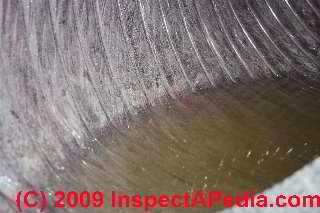
Carol from the very limited information your note lone I tin't be confident in a "estimate" at what the problem is in your dwelling and can only answer in full general. An A/C duct that is non insulated is more likely to produce condensation inside the ductwork than otherwise, particularly in boiling weather.
Such condensate, if information technology collects in the ductwork where it does non vest, instead of in the air handler where it is drained abroad, tin can wet duct insulation (if in that location is some), and can leak onto or into building surfaces.
Moldy drywall is best removed and replaced, allowing yous also to bank check to exist sure the wall cavity was not too wet (and moldy).
Enquire your HVAC service company to inspect the ductwork, fix the crusade of condensation, help you make up one's mind if the interior of the ductwork needs cleaning AND IF it can exist cleaned at all (fiberglass duct interiors don't tolerate cleaning). WHen that problem is cured, so accost the rest of the building.
Watch out: mold can grow to problematic levels in fiberglass insulation in or on wet or previously wet HVAC ducts even when the ducts look clean to the naked center. An explanation of this problem is
at FIBERGLASS INSULATION MOLD
Reader Question: dripping from the HVAC ducts
(Sept 29, 2022) Jyotika Bahree said:
Hi, we simply had our evaporator curl replaced yesterday and the technicians had to alter the ductwork to put the coil in.
Afterwards the work was done, the technicians confirmed that the Ac organisation was cooling properly. After they left, I went to our basement where our HVAC unit is located and institute that there was air leaking from the duct joints where they had put the new coil in.
Thinking that the leakage did not seem normal and might compromise the cooling, I called him to ask most this. He said that they had deliberately not sealed it completely to forestall the organisation from "sweating" too much. Non knowing any meliorate, I had to have what he told me. I would like to go your opinion on this issue.
Please exercise permit me know if this will compromise the arrangement efficiency or if this will truly prevent the arrangement from sweating and therefore we should do nothing.
Respond:
Wait for
1. missing duct insulation
2. condensate bravado off of the cooling coil into ducts near the air handler
Question: does use of bleach or scented candles corrode our air ducts?
I was told products such as clorox, scented candles and sprays crusade corrosion to air and heating lines. Is this true? - June Walker 10/ii/11
Reply:
June, it'southward true that in areas where high levels of chlorine gas are present, such equally effectually indoor pond pools, corrosion of metallic HVAC ducts and even evaporator coils can be a serious problem.
Scented candles? I am very doubtful that in normal utilise y'all could put enough corrosive material into the air to bear upon the ductwork. But indeed utilize of scented candles can be an indoor air quality problem source for some people such as asthmatics, and the soot deposition on indoor surfaces tin be a cosmetic problem as well.
Come across THERMAL TRACKING & HEAT LOSS.
Question: is it ok for a window A/C unit to run continuously for 30 minutes or longer?
Is it ok for a window unit of measurement to stay on cooling for 30+ minutes or will this break the unit, see its above 96 degrees all the time outside and then its hot hot and since I cleaned the evaporator coils & moved thermostat accidentally
I swear it doesn't cutting off & on like before but I simply don't want damage to unit and also coils were dirty earlier and so maybe that's why it cycled quicker and so anyway please help - Christie 7/25/12
Reply:
Christie,
Under normal weather condition (that is for example no abnormal electric voltage levels, proper wiring and installation) a window air conditioner could run continuously, 24-hours a twenty-four hours, without damage to the equipment itself. Of grade if the air filter becomes droppings-clogged and is non cleaned the organization efficiency and effectiveness will decrease, and of class your electric bill volition reflect that connected performance.
See WINDOW / WALL AIR CONDITIONERS for details.
Reader Questions most Wet Corroded Air Ducts
Shirley
If your flat is unsafe / unhealthy and the management is not addressing the situation yous may need to enquire for help from your health department.
My evaporative cooler or condenser and coils need cleaning from debris from gas powered leafage blowers adjacent door twice a week.
I should go my rental payments waived till the slumlord faces her responsibility, she but don't want to pay professional costs.
These apartments should be condemned built in 1949, the slum Lord told u.s.a. not to lick the pigment, it's full of atomic number 82, rusty h2o pipes, mold I demand the Ecology Protection Bureau to test these apartments, they are hazard to our health, and inhabitable to live a good for you living conditions
There'southward mold, rust,atomic number 82 and possibly asbestos thru out fifty-fifty the tile floor and the air feels humid, the Air conditioning is potentially non giving out cool air as fourth dimension goes by we accept a slum Lord that refuses to hire a professional bonded and licenced, they use exfelons to practise the handiwork, and refuses to exterminate by professionals but uses the cheapest extermination using claydirt making your apartment dirty effectually the base of operations iarda and window sills
My apartment below the ceiling is cracking and buckling from the ceiling to the base of operations board
Re-posting from electronic mail:
Anonymous wrote:
I was going through an article on your site on '' Return Air HVAC improvement Guide.''
But my question at present is; What are the furnishings of a corroded return air duct in an air-conditioning arrangement?
Moderator respond:
To ask about the furnishings of corroded render air ductwork in an A/C system is, I concord, a reasonable question in concept but unfortunately ane that however cannot be answered usefully when we take non a shred of information well-nigh the air workout system, ducts, condtion, contamination, amount of corrosion or rust, its cause, possible pathogens in the moisture that caused it, air movement, type of building, other building atmospheric condition that impact the effects, and quite a few other questions.
To give a general ' "it'due south ok" or "it'south dangerous" answer would have no useful reliability.
For example, sewage water leaking from an overhead sewer line into an air-conditioning duct system is unsafe regardless of whether or non the duct is visibly rusty.
In sum, superficial or minor amounts of corrosion or rust in an A/C or heating system air supply OR return duct may exist of itself inconsequential though fifty-fifty then the cause of the corrosion should be considered and probably fixed - such as condensate accident-off or missing duct insulation.
Simply all-encompassing corrosion inside HVAC ducts might point non just that the system is itself damaged and leaky (increasing operating costs and decreasing building condolement) but it might too mean that pathogens such as bacteria or mold are being blown through the system and onto occupants.
I have a plumbing leak that is dripping into my basement duct once I set the leak what can I do to get the corrosion...hard water stains off and restore the expect of my ducts
Days or longer, depending on the materials involved and site weather.
Information technology'southward less the rust, and more than mold, bacterua, or viruses in damp ir wet conditions, that I'd want to investigate.
How long does it accept for rust to form in ac ducks and is information technology hazardous to my wellness. I'm immune compromised. My complex is 30 years old I tin can see the rust on the ac grates in the apartment. What should I practise?
Anon
In general water leaking out of HVAC air ducts is coming from
- condensate blow-off of the cooling coil, possibly requiring fan adjustments, a replacement of a baffle that a tech left out nearly the squirrel muzzle fan - or perhaps a bamboozle that was installed in the incorrect location
- condensate accumlating downstream in ductwork possibly because of missing insulation or air leaks into render ducting
Anon:
Cleaning an air handler might be considered at more than one level of work:
ane. change dirty air filters regularly, unremarkably monthly
2. remove any obvious clods of droppings y'all can reach without disassembly - be sure power is OFF or you could be injured
iii. hire a pro who removes the blower associates, cleans it, lubricates it, cleans out the entire return air compartment, so rebuilds the organization
Details are at BLOWER FAN ASSEMBLY CLEANING http://inspectapedia.com/aircond/Air-Handler-Blower-Cleaning.php
4. Cleaning a dirt-blocked cooling scroll in the air handler is described at DIRTY COIL CLEANING PROCEDURES http://inspectapedia.com/aircond/Cooling_Coil_Cleaning.php
Mine are leaking water as well, how do I clean air handler?
PT
The blower unit - the motorcar that includes a fan and controls to accident conditioned air through the duct system.
Metallic ducts that have been wet simply are non severely damaged can and should be professionally cleaned. Exist sure that the interior of the air handler is also inspected and cleaned - what do y'all mean by air handler?
A UV light will not exercise the least affair about drying out moisture or rusty metal ductwork; IF and I empahsize IF the light were strong plenty and the airflow slow plenty, a UV calorie-free might impale some microorganisms that may be constitute in indoor air or in wet or damp ductwork. It sounds to me that the vendor is proposing to use a tool that they know and sell rather than that the trouble is being properly addressed.
I suggest a duct inspection to find and prepare the cause of the moisture problem, and perchance duct replacement of rusted sections.
when I turn on my fundamental a/c for the first time in the bound ...theres brown balance that comes out of the ducts...the a/c company claims its rust from the ducts in the humid hot attic space they want to install a uv low-cal claiming this will take care of the situation ....im not buying it I feel like I'thou getting scamed...any input would be appreciated
...
Keep reading at H2o & ICE IN DUCT Piece of work or select a topic from the closely-related articles below, or see the complete Article INDEX.
Or run across these
Recommended Articles
- BLOWER LEAKS, RUST & MOLD
- FROST BUILD-Up on AIR CONDITIONER COILS
- Inundation DAMAGE REPAIR PRIORITIES
- Alluvion DAMAGE CLEANUP & REPAIR GUIDE - dwelling house
- HEATING EQUIPMENT, Overflowing DAMAGE REPAIR
- TRANSITE Pipage AIR DUCT ASBESTOS RISKS where we describe flooding of HVAC ductwork in slabs
- PVC HVAC DUCTS
- SLAB DUCTWORK
- WATER & Water ice IN DUCT WORK
- Moisture CORRODED DUCT WORK
Suggested commendation for this spider web page
WET CORRODED DUCT Piece of work at InspectApedia.com - online encyclopedia of building & environmental inspection, testing, diagnosis, repair, & problem prevention advice.
Or see this
INDEX to RELATED Articles: Commodity Alphabetize to HVAC DUCT SYSTEMS
Or use the SEARCH BOX constitute below to Ask a Question or Search InspectApedia
...
Ask a Question or Search InspectApedia
Endeavour the search box merely below, or if you lot prefer, post a question or comment in the Comments box below and we volition respond promptly.
Search the InspectApedia website
Note: advent of your Comment below may exist delayed: if your annotate contains an prototype, web link, or text that looks to the software as if it might be a web link, your posting volition appear after it has been approved past a moderator. Apologies for the delay.
Technical Reviewers & References
Click to Show or Hide Citations & References
Publisher InspectApedia.com - Daniel Friedman
Source: https://inspectapedia.com/aircond/Ducts_Wet_Corroded.php
Posted by: vignajuslithe.blogspot.com


0 Response to "How To Clean Return Ducts With Negative Pressure"
Post a Comment